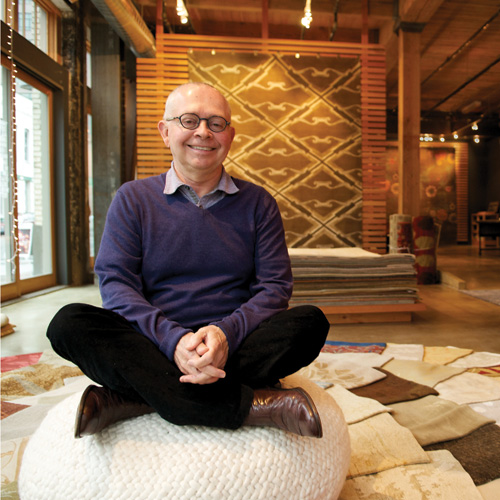 Kerry Smith is a former bread-baking magnate who has transformed the carpet industry by creating Lapchi.
Kerry Smith is a former bread-baking magnate who has transformed the carpet industry by creating Lapchi.
BY LINDA BAKER
 |
Kerry Smith, managing partner of Lapchi, in the company’s Portland atelier// Photo by Eric Näslund |
Kerry Smith, managing partner of carpet company Lapchi, knows a thing or two about beauty — its power and limitations. “Lapchi makes beautiful rugs,” says Smith, sitting in the company’s elegant Pearl District atelier in Portland, featuring floor-to-ceiling windows and an array of silk and wool rugs. “But nobody has a monopoly on beauty,” Smith says. “Beauty is part of the cost of entry. Beauty is not a strategy.”
A former bread-baking magnate with a penchant for yoga and meditation, Smith co-founded Lapchi in Portland in 2001 with $300,000 and a clear objective: to disrupt the dominant business model in the handmade carpet sector, which at the time involved a lot of inventory but limited financial returns.
Twelve years later, Lapchi is the main reason the industry standard today is made-to-order custom rugs. The company itself has sold more than 6,000 custom and handwoven carpets, mostly to hotels, professional firms and high-end residential customers, including hotel chain Ritz-Carlton and Oprah Winfrey. But Lapchi’s innovations also led to new challenges. “We demonstrated there was a better way to sell rugs, and lots of people did it,” says Smith. “The result is a tremendously competitive business.”
To help distinguish the company, especially in an economic downturn, Lapchi continues to adopt initiatives that push convention, including opening new ateliers in several cities, launching new digital marketing strategies and even rethinking the company’s pioneering custom-made approach. Innovation has always been a core value for the company. Changes in the marketplace, he says, simply mean the company must “further refine our strategy.”
Before Lapchi, most high-end rugs made in Asia were purchased from huge piles off showroom floors. Those piles were driven by manufacturers, most of them “fifth to 15th generation, making traditional things, pushing them through the pipeline,” Smith says. For dealers, carrying massive inventories meant a low return on investment. Meanwhile, interior designers — Lapchi sells primarily to the trade — often had to compromise on size, design and color. “No matter how many rugs were in the showroom, they rarely had the perfect rug for the end client,” Smith says.
| Lapchi |
| Managing partner: Kerry Smith |
| Founded: 2001 |
| Employees: 48 |
| Factoid: More than 6,000 custom and handmade rugs sold |
Lapchi — Tibetan for “abode of good energy” — wasn’t the first company to fashion a made-to-order rug. “But we were the first to create a business model based on custom,” says Smith. Lapchi dealers typically purchase just a few rugs in each style, allowing interior designers to then customize for size and color. The manufacturing takes place in Kathmandu, where 30 Lapchi employees oversee the production of the on-demand carpets. Depending on the amount of silk and “knot density” — knots per square inch — a 9-foot-by-12-foot Lapchi rug typically costs between $7,000 and $12,000.
By 2005 most high-end rug dealers had started to adopt the Lapchi approach. But if the company revolutionized the industry, the rug company is also an example of “be careful what you wish for.” Under the new model, dealers no longer need large amounts of capital to purchase hundreds of rugs up front. “We inadvertently demonstrated the barriers to entry were very low,” Smith says. Today, “there are 100 companies doing what we do.”
As competition increased, so did factory costs, which are 70% higher than 12 years ago, Smith says. The recession also hit hard. In 2011 Lapchi grossed about $5 million, down from $6.5 million in 2008. To stay competitive in a tight market, Smith and his partner, Salman Khan, are pressing ahead with new innovations, with a focus on leveraging the atelier concept into higher sales.
Following the opening of the first atelier in Chicago in 2004, Lapchi has added new ateliers in Los Angeles, Cleveland and Portland. These special showrooms display the company’s best practices, from design strategies and new collections to the company’s partnership with GoodWeave, a nonprofit that works to end illegal child labor in the carpet industry.
Last year, Lapchi launched an atelier website. On the regular Lapchi site, a special page for dealers features “color generation” software allowing buyers to plug in different colors and see what the rug looks like online.
In a nod to a fast-paced world, the company also tweaked the custom model by launching a “quick ship” program featuring 24 rugs that are available in three days, compared to four months for a custom product.
Bypassing showrooms altogether in some markets and selling directly to designers is another possibility, says Smith, who is also considering raising venture capital to “really grow the business.”
Regardless of strategy, Smith says everything the company does, from the elegant website to the equally refined ateliers, adheres to the aesthetic principles underlying the rugs themselves, which are distinguished by their use of silk, contemporary color and an artistic design sensibility.
“You can’t be talking about quality and beauty,” says Smith, “and then put out things that are shoddily done.”


